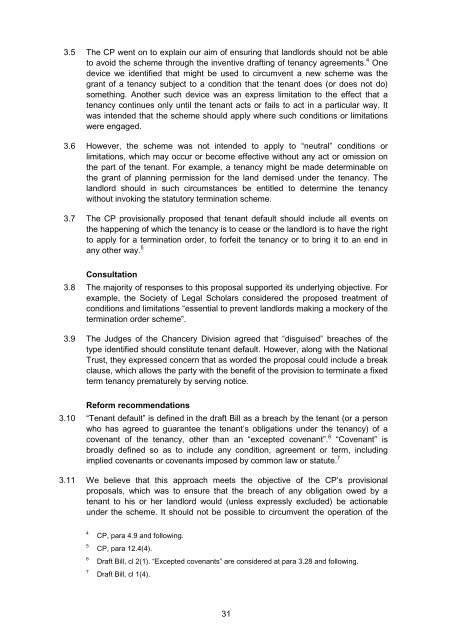Termination of Tenancies for Tenant Default - Law Commission
Termination of Tenancies for Tenant Default - Law Commission
Termination of Tenancies for Tenant Default - Law Commission
You also want an ePaper? Increase the reach of your titles
YUMPU automatically turns print PDFs into web optimized ePapers that Google loves.
3.5 The CP went on to explain our aim <strong>of</strong> ensuring that landlords should not be able<br />
to avoid the scheme through the inventive drafting <strong>of</strong> tenancy agreements. 4 One<br />
device we identified that might be used to circumvent a new scheme was the<br />
grant <strong>of</strong> a tenancy subject to a condition that the tenant does (or does not do)<br />
something. Another such device was an express limitation to the effect that a<br />
tenancy continues only until the tenant acts or fails to act in a particular way. It<br />
was intended that the scheme should apply where such conditions or limitations<br />
were engaged.<br />
3.6 However, the scheme was not intended to apply to “neutral” conditions or<br />
limitations, which may occur or become effective without any act or omission on<br />
the part <strong>of</strong> the tenant. For example, a tenancy might be made determinable on<br />
the grant <strong>of</strong> planning permission <strong>for</strong> the land demised under the tenancy. The<br />
landlord should in such circumstances be entitled to determine the tenancy<br />
without invoking the statutory termination scheme.<br />
3.7 The CP provisionally proposed that tenant default should include all events on<br />
the happening <strong>of</strong> which the tenancy is to cease or the landlord is to have the right<br />
to apply <strong>for</strong> a termination order, to <strong>for</strong>feit the tenancy or to bring it to an end in<br />
any other way. 5<br />
Consultation<br />
3.8 The majority <strong>of</strong> responses to this proposal supported its underlying objective. For<br />
example, the Society <strong>of</strong> Legal Scholars considered the proposed treatment <strong>of</strong><br />
conditions and limitations “essential to prevent landlords making a mockery <strong>of</strong> the<br />
termination order scheme”.<br />
3.9 The Judges <strong>of</strong> the Chancery Division agreed that “disguised” breaches <strong>of</strong> the<br />
type identified should constitute tenant default. However, along with the National<br />
Trust, they expressed concern that as worded the proposal could include a break<br />
clause, which allows the party with the benefit <strong>of</strong> the provision to terminate a fixed<br />
term tenancy prematurely by serving notice.<br />
Re<strong>for</strong>m recommendations<br />
3.10 “<strong>Tenant</strong> default” is defined in the draft Bill as a breach by the tenant (or a person<br />
who has agreed to guarantee the tenant’s obligations under the tenancy) <strong>of</strong> a<br />
covenant <strong>of</strong> the tenancy, other than an “excepted covenant”. 6 “Covenant” is<br />
broadly defined so as to include any condition, agreement or term, including<br />
implied covenants or covenants imposed by common law or statute. 7<br />
3.11 We believe that this approach meets the objective <strong>of</strong> the CP’s provisional<br />
proposals, which was to ensure that the breach <strong>of</strong> any obligation owed by a<br />
tenant to his or her landlord would (unless expressly excluded) be actionable<br />
under the scheme. It should not be possible to circumvent the operation <strong>of</strong> the<br />
4 CP, para 4.9 and following.<br />
5 CP, para 12.4(4).<br />
6 Draft Bill, cl 2(1). “Excepted covenants” are considered at para 3.28 and following.<br />
7 Draft Bill, cl 1(4).<br />
31

















